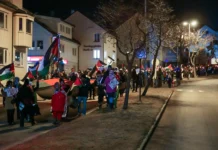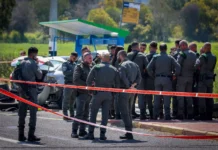Romans marched on Monday to commemorate the anniversary of when over one thousand Jews were taken from their homes by Nazis in 1943 and sent to the concentration camp of Auschwitz. As anti-semitic sentiments rise in Europe and the United States, Catholic and Jewish organizers of the event praise fruitful dialogue and invite faithful not to forget the lessons from the past.
From the desecration of Jewish cemeteries in the United States to a recent spike in violence against Jews in many parts of Europe, it’s obvious that the rise of populist and nationalistic movements around the world has reinforced – and in some cases even fomented – anti-Semitic sentiments.
In that context, a silent march that took place in Rome Oct. 16, marking the date when more than a thousand Jews were taken from the Roman Ghetto to Nazi concentration camps in 1943, takes on a special meaning.
The 23rd edition of the event, organized by the Community of St. Egidio, a global lay Catholic organization, as well as the Jewish Community in Rome, was a joint effort to show that the Eternal City is committed to preserving its memory, while being mindful of the past.
“To see the crowd of people holding candles arrive, every time more numerous, is – I must admit – very exciting,” Claudia Fellus, Vice President of the Jewish Community in Rome, told Crux in an interview. “Because it’s a moment when the city, or part of the city at least, remembers that event and not only that, but also the silences and omissions.”
On that date 74 years earlier, Nazis surrounded the historic ghetto of Rome in the early hours of the morning and captured more than one thousand Jewish people and led them to a military compound. From there, they were brought to the Tiburtina train station, where they were thrown onto eighteen cattle wagons and sent to the Auschwitz concentration camp.
The Roman Jews arrived at the death camp on Oct. 22, and more than 700 were immediately killed in the gas chambers. Only 16 people survived, of which only one was a woman. Not even one of the many children who were rounded up made it back.
It therefore strikes a note when children from different cultural and religious backgrounds lead the march every year, holding a banner saying, “There is no future without memory.”
The need to preserve, and learn from, the legacy of the past becomes even more important considering that the “living witnesses” who saw and experienced the Holocaust (referred to in Hebrew as the Shoah) are getting older and dying, right at a time when the world could use their important lessons.
Speaking at the march, Bishop Ambrogio Spreafico, who heads a commission for interreligious dialogue for the Italian episcopal conference, reminded Jews and Christians who were present that anti-Semitism is in no way a thing of the past, but can be seen in the countless number of tweets and Facebook pages riddled with comments attacking the Jewish community.
The event “remembers the pain from the past, but generates the commitment to move on side-by-side with one another,” Spreafico said. “We will always be with the Jewish community, because we want to create a world without division. Our being together is a message of life and cohabitation, it’s a firm answer to anti-Semitism and to every form of racism and separation.”
More than a thousand people participated in the march, which began at the Church of Santa Maria in Trastevere, the headquarters of St. Egidio in Rome, and arrived at the Synagogue in the Jewish Ghetto. The path is the exact opposite from that which the Roman Jews took in 1943, and evokes a certain “coming home” in honor of all those who never did.
Father Marco Gnavi of the church of Santa Maria in Trastevere described the march as “a true revolt against the evil and the absurdity of racism and anti-Semitism, which today we see dangerously reawakening.
By now, more than thirty years have passed since Saint Pope John Paul II visited the Roman Synagogue in 1986 and called for further dialogue and understanding between Catholics and Jews, whom he called “our older brothers.” Yet centuries had to go by before that dialogue could happen, after hundreds of years of persecutions, forced conversions, and segregation ordered by many popes.
“Today relations with the Vatican are good. The dialogue between Catholicism and Judaism continues to move forward, and this is very important,” Fellus told Crux, pointing to the march and the initiatives brought forth by Pope Francis as positive signs of good faith.
Speaking to a delegation from the Anti-Defamation League last February at the Vatican, Francis underlined that “the Catholic Church feels particularly obliged to do all that is possible with our Jewish friends to repel anti-Semitic tendencies.”
Such tendencies creep up constantly around the globe, including in Rome, where leaders of the Italian right wing party New Force (Forza Nuova) want to lead a “March on Rome” this Oct. 28, which is the anniversary of fascist dictator Benito Mussolini’s forceful entrance into political life.
Organizers have stated that the purpose of the march is to oppose a proposal for granting citizenship to children of immigrants born on Italian soil – an issue that has been under debate in the country – but the choice of the date cannot help but raise concerns. The leader of the party, Roberto Fiore, insisted that the march would not be “fascist or nostalgic,” and that its aim is to oppose immigration policies he says are promoted in Europe by George Soros, the billionaire investor and philanthropist of Jewish ancestry.
“Anti-Semitism reemerges in moments of economic and social crisis,” Fellus said, adding, “today there is fear once more.” She also highlighted how, for many years in the wake of WWII, certain discriminatory things could not be said or evoked, while “today one can say anything and state anything.
“I read terrifying things on the internet,” she said.
The Jewish community has historically – and unwillingly – been the sentinel of destabilization and persecution around the globe as well as the careful custodian of the memory of how dangerous nationalism taken to the extreme can be. As Rome’s Chief Rabbi said during the march, remembering means to “rebuild our society,” which according to him “is losing its antibodies.”
Fellus insisted that the rise of nationalism is not only bad news for the Jewish community but for all and pointed out that WWII caused “the death of six million Jews in Europe, but also the death of 25 million Europeans.”
The representative of the Jewish community in Rome is skeptical about the future of Europe, which she believes “has closed its eyes” to the lessons from the past, but Fellus remains trusting in the future of the United States.
“No matter what, for the rest of my days, I will be grateful to the Americans for what they have done,” Fellus said. “Because when they arrived to liberate Rome, they saved us,” she said referring to the arrival of U.S. troops in Italy toward the end of WWII.
“I have faith in American democracy,” she continued, “which is such to reject things that surpass a certain limit” and has been able to “always find itself in the end.”

























